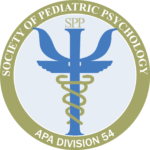SPP Communications Expectations and Guidelines
Use of Logo Guidelines
- The Society of Pediatric Psychology Logo may be used on materials related to approved Division 54 activities including Special Interest Groups and Regional Interest Groups.
- The Logo may be resized, so long as all elements remain in proportion.
- Colors of the logo may not be changed, however it may be converted to black and white or grayscale.
- Avoid using copy and paste to transfer logos. Use the Society of Pediatric Psychology Media Package to download high resolution photos HERE (to be added at later date).


Expectations
- Special Interest Groups, Affinity Groups, Regional Interest Groups, and the Student Advisory Board must report their communication channels (public and members-only) to the Division 54 board annually along with the names of the individuals who have access.
- If a communication channel, such as a social media account, is no longer going to be active, the group should remove it by canceling the account.
- Usernames and passwords for all media accounts should be shared in a very limited manner. Every group should have a plan for how usernames and passwords will be shared and passed down.
- You must have obtained written consent (e.g., via email) for photos of individuals that may appear on media outlets. Please be certain of this consent, as once something is posted, it is generally not possible to remove from all online locations. If you put images on your website, include a statement that says “Individuals represented in photos gave permission for their image to be used. Requests to remove imagines can be sent to any member of the Division 54 leadership team.
- The work of Division 54 is clinical in nature and members are licensed healthcare professionals. As such, it is important to be clear that messaging is not assumed to be medical advice. Please use the following statement on websites or social media accounts.
Guidelines
- Use of inclusive language is strongly encouraged. Guidelines for use of inclusive language can be found here: APA Inclusive Language and Microsoft Bias-free Communication.
- Do not endorse nor speak against a candidate for political office nor a political party, nor engage in any other activity that could be perceived as electioneering or influencing federal, state, or local political office. Further, if you do post about politics, political viewpoints, elections, or similar topics be certain to link it to science. For example, comments on how elections might cause stress for parents and children or how certain populations are disproportionately affected by certain policies are within our purview. However, endorsing a political party or individual running for office due to their policies is not allowed. For more regarding Political Statements, see here: APA Listserv Usage Rules.
- Consider health literacy issues, use plain language, and avoid jargon.
- Plan for how you will deal with comments on posts. Consider turning comments off. Be aware of how you can delete inappropriate comments if necessary.
- Keep in mind the audience. Be aware that posts can be seen by anyone, including children and vulnerable populations.
- Be sure that scientific information shared is accurate. This is particularly important if you are re-sharing information developed by another individual or group.
- Follow your institutional policies regarding your activity on social media.
- Be aware of conflicts of interest. If you are getting paid for a product or idea that must be revealed. In general, please avoid any posting that presents even an appearance of conflict of interest, particularly when using SPP accounts.
- Consider the ethical implications of your endorsements and statements, and make sure they are consistent with current standards of care, evidence-based medicine, and the Mission of the Society of Pediatric Psychology.
- Clearly describe who you are and what you do.
- Be aware of copy-righted material and images.
- Keep in mind the benefits of using social media and the opportunity to disseminate accurate information, promote healthcare, and share tips to support children and families.
- Make content as accessible as possible. Recommendations to increase accessibility can be found here: Federal Social Media Accessibility Toolkit.
- Infographics, including Instagram posts, should be clearly marked with their source.
- Give credit (cite sources) when you post information developed by another individual or group.
- To respond to pseudoscience and misinformation found in media, it is recommended that you create a new post to state the science (with proper citation) rather than commenting on others’ posts.
- As a rule, you should cite a source if providing a statement as fact.
How to Tweet
The American Psychological Association (APA) has published a Social Media/Forum Policy. These policy guidelines should be followed by Division 54 and its subgroups. Detailed information regarding this policy can be found on the APA website here: APA Social Media/Forum Policy.
